|
|
|
Sort Order |
|
|
|
Items / Page
|
|
|
|
|
|
|
| Srl | Item |
| 1 |
ID:
133222
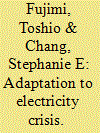

|
|
|
|
|
| Publication |
2014.
|
| Summary/Abstract |
Electricity crises can spur improvements in electricity conservation that would be unachievable under normal circumstances. This paper investigates how businesses adapted to electricity shortages following the March 11, 2011, Great East Japan earthquake, tsunami, and nuclear disaster. In summer 2011, mandatory and voluntary electricity conservation measures affected nearly all of Japan, and peak hour electricity consumption was reduced by a remarkable 18% in the Tokyo region. Using statistical data from 14 business surveys conducted in 2011 and 2012, this paper identifies patterns with regard to type of adaptation, conservation requirements, economic sector, and timeframe. Results indicate that behavioral adaptations (e.g., reduction of illumination or air conditioning) were much more common than schedule adaptations (e.g., shifting production times) or hardware adaptations (e.g., installing energy-efficient devices or private generators). Adaptation patterns were very similar between mandatory and voluntary conservation areas. Manufacturing companies were more likely to implement schedule adaptations than other companies. Certain types of adaptations persisted into 2012, especially reduction of illumination and air conditioning, and installation of energy-efficient devices. These insights may be useful for informing electricity conservation policies in non-crisis contexts.
|
|
|
|
|
|
|
|
|
|
|
|
|
|
|
|
| 2 |
ID:
133215


|
|
|
|
|
| Publication |
2014.
|
| Summary/Abstract |
The current project-based carbon market mechanisms such as the Clean Development Mechanism (CDM) and the Joint Implementation (JI) do not have a direct impact on global greenhouse gas emission levels, because they only replace or offset emissions. Nor do they contribute to host country×s national greenhouse gas emission reduction targets. Contributions to net emission reductions in host countries is likely to become mandatory in new mechanisms under development such as in the framework for various approaches, a new market-based mechanism and even in a reformed JI. This research analysed the question if approaches for carbon market-based mechanisms exist that allow the generation of net emission reductions in host countries while keeping project initiation attractive. We present a criteria-based assessment method and apply it for four generic options in existing mechanisms and derive implications for future mechanism frameworks. We identified the application of "discounts" on the amount of avoided emissions for the issuance of carbon credits and "standardisation below business as usual" as most promising options over "limiting the crediting period" and "over-conservativeness". We propose to apply these options differentiated over project types based on internal rate of return to ensure cost-efficiency and attractiveness.
|
|
|
|
|
|
|
|
|
|
|
|
|
|
|
|
| 3 |
ID:
133182
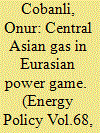

|
|
|
|
|
| Publication |
2014.
|
| Summary/Abstract |
Following the dissolution of the Soviet Union, various gas pipeline projects have been proposed to diversify transit routes and export markets of the landlocked Central Asian states. To evaluate the pipeline project's impact on the players' bargaining power, I apply the cooperate game theory to a quantitative model of the Eurasian gas trade and quantify the bargaining power structure via the Shapley value. Due to ample production capacities in Central Asia, I observe little strategic interaction between the West and China. Thus, demand competition with China is not necessarily a disadvantage for the West, and the Turkmenistan-China pipeline does not affect the impact of the westbound projects aiming Europe and Turkey. For Turkmenistan, i.e., the main supplier in the region, a link via the Caspian Sea to Turkey is the most beneficial westbound option. Although the projects carrying gas from Azerbaijan and Turkmenistan to Europe enjoy the European Commission's political support, they yield marginal benefits to the European consumers. Thanks to its transit position, Turkey collects a large share of the benefits in the East-West gas trade.
|
|
|
|
|
|
|
|
|
|
|
|
|
|
|
|
| 4 |
ID:
133101
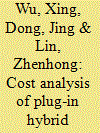

|
|
|
|
|
| Publication |
2014.
|
| Summary/Abstract |
Using spatial, longitudinal travel data of 415 vehicles over 3-18 months in the Seattle metropolitan area, this paper estimates the operating costs of plug-in hybrid electric vehicles (PHEVs) of various electric ranges (10, 20, 30, and 40 miles) for 3, 5, and 10 years of payback period, considering different charging infrastructure deployment levels and gasoline prices. Some key findings were made. (1) PHEVs could help save around 60% or 40% in energy costs, compared with conventional gasoline vehicles (CGVs) or hybrid electric vehicles (HEVs), respectively. However, for motorists whose daily vehicle miles traveled (DVMT) is significant, HEVs may be even a better choice than PHEV40s, particularly in areas that lack a public charging infrastructure. (2) The incremental battery cost of large-battery PHEVs is difficult to justify based on the incremental savings of PHEVs' operating costs unless a subsidy is offered for large-battery PHEVs. (3) When the price of gasoline increases from $4/gallon to $5/gallon, the number of drivers who benefit from a larger battery increases significantly. (4) Although quick chargers can reduce charging time, they contribute little to energy cost savings for PHEVs, as opposed to Level-II chargers.
|
|
|
|
|
|
|
|
|
|
|
|
|
|
|
|
| 5 |
ID:
133294


|
|
|
|
|
| Publication |
2014.
|
| Summary/Abstract |
Large-scale deployment of low-carbon energy technologies is crucial to mitigating climate change, and public support is an important barrier to policies and projects that facilitate deployment. This paper provides insights to the origins of public opposition that can impede the adoption of low-carbon technologies by investigating how perceptions are shaped by local economic interests and individual cultural worldviews. The research considers both carbon capture and storage and wind energy technologies because they differ in maturity, economic impact and resource base. Further, for each technology, the research examines support for two types of policies: deployment in local community and public funding for research and development. Results indicate the influence of economic interests and cultural worldviews is policy specific. Individual cultural worldviews do not affect support for the deployment of technology, but they do significantly influence a person×s support for publicly funded research and development. Conversely, local economic interests have a significant role in determining support for deployment, while they do not affect support for research and development.
|
|
|
|
|
|
|
|
|
|
|
|
|
|
|
|
| 6 |
ID:
133115


|
|
|
|
|
| Publication |
2014.
|
| Summary/Abstract |
Building energy efficiency rating systems have been established worldwide to systematically manage the energy consumption of existing buildings. This study aimed to develop a new energy efficiency rating system for existing residential buildings from two perspectives: (i) establishment of reasonable and fair criteria for the building energy efficiency rating system; and (ii) establishment of comparative incentive and penalty programs to encourage the voluntary participation of all residents in the energy saving campaign. Based on the analysis of the conventional energy efficiency rating system for existing residential buildings, this study was conducted in five steps: (i) data collection and analysis; (ii) correlation analysis between the household size and the CO2 emission density (i.e., CO2 emission per unit area); (iii) cluster formation based on results of the correlation analysis using a decision tree; (iv) establishment of a new energy efficiency rating system for existing buildings; and (v) establishment of incentive and penalty programs using advanced case-based reasoning. The proposed system can allow a policymaker to establish a reasonable and fair energy efficiency rating system for existing residential buildings and can encourage the voluntary participation of all residents in the energy saving campaign.
|
|
|
|
|
|
|
|
|
|
|
|
|
|
|
|
| 7 |
ID:
133213


|
|
|
|
|
| Publication |
2014.
|
| Summary/Abstract |
This paper estimates the relationships between bidding quantities, marginal cost and market power measures in the Spanish wholesale electricity market for two different regulatory periods: 2002-2005 and 2006-2007. Using panel econometric techniques we find differences in the impacts on bidding strategies for both periods. Hence, the marginal cost and the market power measures affect bid and net quantities. The market power measures also suggest that the coefficient is consistently positive and highly significant for both periods.
Moreover, the market power and marginal costs have mixed effects according to the models proposed for both periods. In addition, our results point to the effectiveness of the different effects of mitigating the market power in the Spanish electricity market. For the 2006-2007 period, the proposed causal relationships are partially validated by the cointegration results, which assumes there is a significant causality between the Lerner Index and the marginal cost.
|
|
|
|
|
|
|
|
|
|
|
|
|
|
|
|
| 8 |
ID:
133179


|
|
|
|
|
| Publication |
2014.
|
| Summary/Abstract |
Thermal stratification within hot water tanks maximises the availability of stored energy and facilitates optimal use of both conventional and renewable energy sources. However, stratified tanks are also associated with the proliferation of pathogenic bacteria, such as Legionella, due to the hospitable temperatures that arise during operation. Sanitary measures, aimed at homogenising the temperature distribution throughout the tank, have been proposed; such measures reduce the effective energy storage capability that is otherwise available. Here we quantify the conflict that arises between thermodynamic performance and bacterial sterilisation within 10 real world systems. Whilst perfect stratification enhances the recovery of hot water and reduces heat losses, water samples revealed significant bacterial growth attributable to stratification (P<0.01). Temperature measurements indicated that users were exposed to potentially unsanitary water as a result. De-stratifying a system to sterilise bacteria led to a 19% reduction in effective hot water storage capability. Increasing the tank size to compensate for this loss would lead to an 11% increase in energy consumed through standing heat losses. Policymakers, seeking to utilise hot water tanks as demand response assets, should consider monitoring and control systems that prevent exposures to unsanitary hot water.
|
|
|
|
|
|
|
|
|
|
|
|
|
|
|
|
| 9 |
ID:
133227
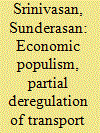

|
|
|
|
|
| Publication |
2014.
|
| Summary/Abstract |
The Indian political class is known to employ populist, albeit economically unsustainable, measures to replace intrinsic 'valence', especially shortly prior to election windows. Such measures include loan-waivers, interest rate concessions, provision of free electricity for agriculturists, etc. The union government's leverage to maneuver and to micro-manage retail fuel prices within partially deregulated environments is hypothesized to provide incumbents with an advantage over rival contestants in the electoral process. This paper analyzes the evolution in the retail prices of diesel and petrol (gasoline), and the transfer of such evolution, into the inflation index of the 'all commodity' basket. It is observed that when international benchmark prices are relatively low and domestic inflation is moderate, the transfer occurs within about 42 weeks. During periods of high oil prices-frequently above USD 100 a barrel-and high inflation-higher than 5.00-5.50%-prices of petroleum distillates tend to feed into overall inflation more rapidly, within about 34-40 weeks.
The study, covering a total of 82 elections for the central and state (provincial) governments during the period 2000 to 2013, concludes that even as patterns of manipulation of prices are apparent, ceteris paribus, such leverage does not necessarily seem to translate into favorable electoral outcomes. This conclusion reiterates observations that economic im/prudence may not necessarily determine electoral outcomes, and that the basis for electoral choices made by the Indian voter-consumer remains subjective.
|
|
|
|
|
|
|
|
|
|
|
|
|
|
|
|
| 10 |
ID:
133121
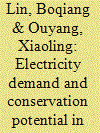

|
|
|
|
|
| Publication |
2014.
|
| Summary/Abstract |
As the high energy-consuming manufacturing industry, electricity consumption of nonmetallic mineral products in China accounted for 7.93% of industrial, 5.84% of national and 1.33% of global electricity consumption in 2010. This study attempts to specify the determinants of sectoral electricity demand, forecast future electricity consumption by creating a model using the Johansen cointegration methodology and estimate the sectoral electricity conservation potential. Results indicate that GDP per capita is the leading force explaining the sectoral electricity consumption increase, while value-added per worker, R&D intensity and electricity price are the main factors contributing to the sectoral electricity consumption decrease. Results demonstrate that sectoral electricity consumption in 2020 will be 369.79-464.83 billion kWh under the low-growth scenario and 530.14-666.39 billion kWh under the high-growth scenario. Moreover, under the low-growth scenario, the sectoral electricity conservation potential in 2020 will be 33.72-95.03 billion kWh, accounting for 0.45-1.26% of China's total electricity demand in 2020; under the high-growth scenario, the sectoral electricity conservation potential in 2020 will be 48.34-136.24 billion kWh, accounting for 0.26-0.74% of world's total electricity consumption in 2010 respectively. Finally, we provide some policy recommendations for encouraging energy conservation in China's nonmetallic mineral products industry.
|
|
|
|
|
|
|
|
|
|
|
|
|
|
|
|
| 11 |
ID:
133031


|
|
|
|
|
| Publication |
2014.
|
| Summary/Abstract |
China has adopted targets for developing renewable electricity that would require expansion on an unprecedented scale. During the period from 2010 to 2020, we find that current renewable electricity targets result in significant additional renewable energy installation and a reduction in cumulative CO2 emissions of 1.8% relative to a No Policy baseline. After 2020, the role of renewables is sensitive to both economic growth and technology cost assumptions. Importantly, we find that the CO2 emissions reductions due to increased renewables are offset in each year by emissions increases in non-covered sectors through 2050. We consider sensitivity to renewable electricity cost after 2020 and find that if cost falls due to policy or other reasons, renewable electricity share increases and results in slightly higher economic growth through 2050. However, regardless of the cost assumption, projected CO2 emissions reductions are very modest under a policy that only targets the supply side in the electricity sector. A policy approach that covers all sectors and allows flexibility to reduce CO2 at lowest cost - such as an emissions trading system - will prevent this emissions leakage and ensure targeted reductions in CO2 emissions are achieved over the long term.
|
|
|
|
|
|
|
|
|
|
|
|
|
|
|
|
| 12 |
ID:
133228
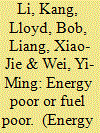

|
|
|
|
|
| Publication |
2014.
|
| Summary/Abstract |
Energy poverty and fuel poverty are descriptors of problems of households' energy consumption, they are both distinct problems and have been addressed by many researchers, organizations and governments. Cross use of the terms of energy poverty and fuel poverty in published papers is common. As an accurate descriptor is the presupposition of research and policy development, especially for those who just started to pay attention to this issue, this paper compares the definitions, research priorities, status quo, and problems of these two concepts, and summarizes the relationship between them. The paper suggests that only when the research targets are households who are living in a cold climate and have difficulty in getting access to electricity or modern cooking facilities, and in supplying indoor heating with appropriate cost, the concepts of energy poverty and fuel poverty have the chance to be broadened and mutually integrated.
|
|
|
|
|
|
|
|
|
|
|
|
|
|
|
|
| 13 |
ID:
133217
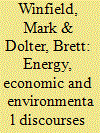

|
|
|
|
|
| Publication |
2014.
|
| Summary/Abstract |
This paper examines the debates around the Ontario×s Green Energy and Green Economy Act (GEGEA) as an energy and economic development strategy through comparative public policy and discourse analysis approaches. The evidence regarding the economic impacts of the GEGEA is found to be almost entirely based on the results of economic modeling exercises. Critics and supporters of the legislation have arrived at very different conclusions through such exercises. These outcomes are similar to those seen in other jurisdictions pursuing renewable energy initiatives, such as Feed In Tariffs (FITs), renewables obligations and portfolio standards. A discourse analysis approach is employed to examine the reasons for the different conclusions being reached over the impacts of renewable energy initiatives. Differences in modeling approaches and assumptions are found to reflect differences in ideational perspectives on the part of the modelers with respect to the appropriate roles of markets and the state and the relationship between economic development and environmental sustainability in public policy. The paper concludes with suggestions regarding the gathering and availability of information regarding economic development in the renewable energy sector, and a discussion of potential ways to strengthen future efforts to understand the economic and environmental impact of renewable energy initiatives.
|
|
|
|
|
|
|
|
|
|
|
|
|
|
|
|
| 14 |
ID:
133156


|
|
|
|
|
| Publication |
2014.
|
| Summary/Abstract |
The recent discovery of significant offshore natural gas reserves in the Aphrodite field, south of the island of Cyprus in the Mediterranean Sea, changes the energy landscape in the greater Mediterranean-Middle East-Caucasian Region. In this paper, different alternative locations for the construction and operation of a liquefied natural gas (LNG) terminal station in Cyprus were evaluated, explicitly considering also their connection to the power generation station of Mari and the country×s gateway.
The problem of determining the optimal location for an LNG terminal in Cyprus has been approached using multiple methodological components, which consider environmental and transportation issues, both technocratic in nature, as well as more subjective and based on expert opinion. The first step was a REGIME multi-criteria decision analysis used to prioritize alternative LNG terminal locations. Then, multiple modes (railroad and pipeline) of transportation connections were evaluated and geometric alignments were proposed, considering a multitude of restrictions. Finally an environmental impact assessment based on a structured questionnaire and an expert panel was conducted to validate and assess the impact of the alternative options (combination of location and transportation mode and route). During the evaluation process parameters such as safety, existing infrastructure, and access were also considered.
|
|
|
|
|
|
|
|
|
|
|
|
|
|
|
|
| 15 |
ID:
133312


|
|
|
|
|
| Publication |
2014.
|
| Summary/Abstract |
We evaluate the contribution of technological change in reducing CO2 emissions in the Italian pulp and paper industry during the first and second phases of application of the European Union Emission Trading System (EU-ETS). We decompose the variation in emission and emission intensity into three different types of effects: a composition effect, a technique effect and a scale effect. The composition effect measures the change in emissions and emissions intensity due to a shift in production towards products that cause less emissions. The technique effect measures the change per each type of product, thereby accounting for technology improvements in the production of each type of good produced. The scale effect singles out the reduction in total emission due to an overall reduction in output. We show that the first phase of the application of EU-ETS has led to a reduction in both emissions and emission intensity due to the composition effect. The technological change has had a limited negative impact on emissions in the first phase, while in the second phase there has been limited technology improvement in the industry. However, the figures of the scale effect show that the larger reduction in emission is due to the overall decrease in output.
|
|
|
|
|
|
|
|
|
|
|
|
|
|
|
|
| 16 |
ID:
133043


|
|
|
|
|
| Publication |
2014.
|
| Summary/Abstract |
We have calculated annual (i.e., for each day of the year) daytime dependences of the electric power output per unit area of an a-Si:H solar cell (SC) at latitudes 45°N, 50°N, 55°N, 60°N and at certain geographical points of Russia, Kazakhstan, Ukraine and Belarus. The calculations were based on a rigorous theoretical model, which allows to determine photoconversion efficiency, optimal electric power output and other photovoltaic electrical characteristics at arbitrary angles of solar irradiance incidence on an a-Si:H-based SC. Parameters of the a-Si:H SC under consideration provide photoconversion efficiency of 10% at 12:00 noon on equinox day at the 45°N latitude despite small total thickness of 0.7 µm of the a-Si:H SC structure up to the rear contact. Normalization of the obtained results by maximal values enables one to infer respective time dependencies for other types of SCs. In combination with the data on average numbers of sunny days per year (or average annual sunshine hours) for certain geographical regions, this provides a way for understanding the feasibility of solar electricity generation in these regions. Based on this study, we identify regions of Russia, Kazakhstan and Ukraine, for which electricity generation exceeds the average values by over 30%.
|
|
|
|
|
|
|
|
|
|
|
|
|
|
|
|
| 17 |
ID:
133013


|
|
|
|
|
| Publication |
2014.
|
| Summary/Abstract |
Many advanced industrialized countries have, in recent years, experienced a significant expansion of electricity production from renewables. Yet we know quite little about the dynamics of the underlying policychoices in this area. Using new data on adoptions and changes in feed-in tariff and green certificate schemes in 26 advanced industrialized countries over 20 years, we examine both domestic driving forces as well as international determinants. The findings suggest that three factors play a particularly important role in pushing countries towards market-based support systems: characteristics of the existing energy supply system, a federalist structure of the political system, and EU membership. Particularly noteworthy is the finding that higher shares of fossil and nuclear energy in the national energy supply as well as higher CO2intensity of the economy do not, as we had expected, stand in the way of policies for supporting renewables in electricity production. To the contrary, they increase the likelihood of a country adopting such policies. We also find, however, that higher economic growth and higher growth in solar and wind energy capacity tend to reduce the political appetite for reforms of existing schemes.
|
|
|
|
|
|
|
|
|
|
|
|
|
|
|
|
| 18 |
ID:
133027


|
|
|
|
|
| Publication |
2014.
|
| Summary/Abstract |
In 1998, the South African government developed an energy policy that focused on a pro-poor agenda. Its objectives included addressing the health impacts of solid fuel use in households. Fourteen years later, and with household electrification at over 80%, millions still use solid fuels and yet ambitious policy objectives to address this situation are not being met. Using three theoretical frameworks; institutional capacity, policy inheritance and the symbolic use of policy, this paper analyses the reasons why household energy policy objectives related to solid fuels and health, as stated in the 1998 South African energy policy, have not been implemented. The results of the analysis show that the symbolic use of policy, including meanings of objects used for meeting policy objectives is the most critical explanation. The paper illustrates that political and historical contexts are critical to understanding policy outcomes in developing and transition countries which often experience tensions between implementing what may seem as objective policies, and that matches their political and historical experiences and aspirations. We recommend that policy analysts in the energy sector complement currently common methods to include political contexts of policy development and implementation in order to better understand why policy makers chose to implement certain policies over others.
|
|
|
|
|
|
|
|
|
|
|
|
|
|
|
|
| 19 |
ID:
133144
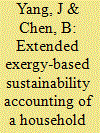

|
|
|
|
|
| Publication |
2014.
|
| Summary/Abstract |
Biogas has been earmarked as one of the leading renewable energy sources capable of mitigating environmental emissions in rural areas. Thus, developing an accounting technique is of particular importance in coping with increasing problems related to renewable agriculture and rural energy supply. In this study, extended exergy was generalised for the sustainability evaluation of biogas projects. Furthermore, a series of extended exergy-based indicators was presented as benchmarking from the perspectives of resources, economics and greenhouse gas (GHG) emissions. The sustainability of a "Three-in-One" biogas production system in southern China was thereby evaluated based on the proposed framework. The results show that economic costs concentrate in the construction phase. GHG emissions are mainly derived from bricks and cement, with proportions of 36.23% and 34.91%, respectively. The largest resource depletion occurs during the consumption of feedstock (87.06%) in the operation phase. Compared with other renewable energy conversion systems, the biogas project has a higher renewability (0.925) and economic return on investment ratio (6.82) and a lower GHG emission intensity (0.012). With the merit of bridging thermodynamics and externality, the extended exergy-based approach presented in this study may effectively appraise the energy and environmental performance of biogas projects.
|
|
|
|
|
|
|
|
|
|
|
|
|
|
|
|
| 20 |
ID:
133142


|
|
|
|
|
| Publication |
2014.
|
| Summary/Abstract |
In this paper, we identify key drivers and barriers for the adoption of building energy retrofits in Germany, which is promoted by public policy as an important measure to address the future challenges of climate change and energy security. We analyze data from a 2009 survey of more than 400 owner-occupiers of single-family detached, semidetached, and row houses in Germany, that was conducted as a computer-assisted personal interview (CAPI). In the survey, respondents were asked directly for reasons for and against retrofitting their homes, but also faced a choice experiment involving different energy retrofit measures. Overall, we find that house owners who are able to afford it financially, for whom it is profitable, and for whom there is a favorable opportunity are more likely to undertake energy retrofit activities. The latter point seems to be of particular importance in explaining the persistent low retrofit rate in Germany. Our results suggest that professional energy advice could stimulate the demand for building energy retrofits.
|
|
|
|
|
|
|
|
|
|
|
|
|
|
|
|
|
|
|
|
|